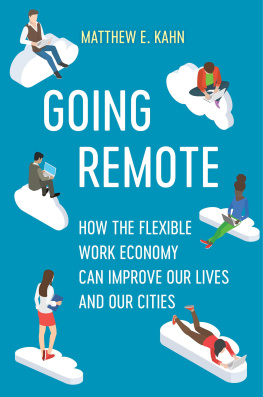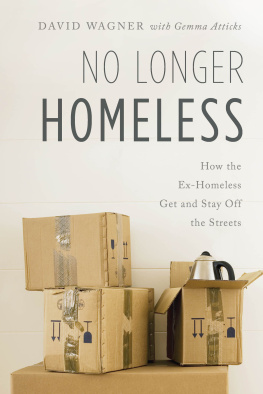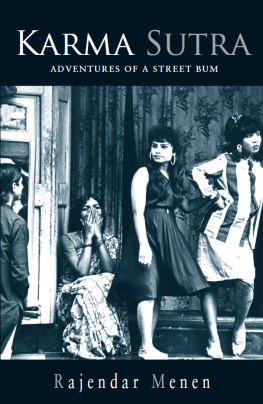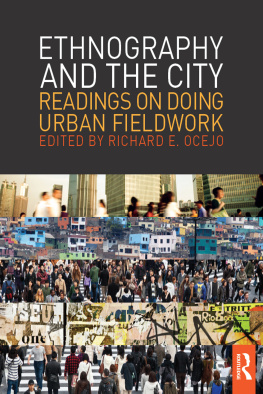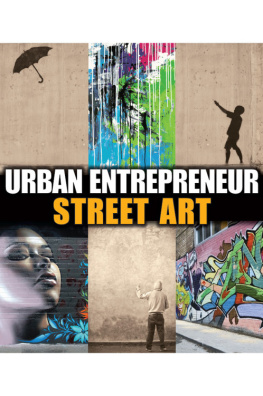Footwork
Footwork
Urban Outreach
and Hidden Lives
Tom Hall
First published 2017 by Pluto Press
345 Archway Road, London N6 5AA
www.plutobooks.com
Copyright Tom Hall 2017
The right of Tom Hall to be identified as the author of this work has been asserted by him in accordance with the Copyright, Designs and Patents Act 1988.
British Library Cataloguing in Publication Data
A catalogue record for this book is available from the British Library
ISBN 978 0 7453 3058 7 Hardback
ISBN 978 0 7453 3057 0 Paperback
ISBN 978 1 7837 1764 4 PDF eBook
ISBN 978 1 7837 1766 8 Kindle eBook
ISBN 978 1 7837 1765 1 EPUB eBook
This book is printed on paper suitable for recycling and made from fully managed and sustained forest sources. Logging, pulping and manufacturing processes are expected to conform to the environmental standards of the country of origin.
Typeset by Stanford DTP Services, Northampton, England
Simultaneously printed in the United Kingdom and United States of America
For Luke, Lily and Georgie, and Sarah
People cannot simply disappear, abdicate from the soap opera of the city; they must reappear: even the ones who have never been seen before.
Iain Sinclair, City of Disappearances
Arent you going to take any notes? she asked.
I grunted.
I thought detectives always wrote things down in little note-books.
Ill make the gags, I said.
Raymond Chandler, The Little Sister
Contents
Acknowledgments
All through writing this book I have kept mostly to myself, being lucky in the choice of a very few close friends and colleagues; I owe a particular debt to those who kept their own counsel and left me to it. Robin Smith has been my closest collaborator for some years and for many more to come, I hope; he has shared in the fieldwork and knows this book as well as anyone (having read none of it); I have borrowed from our many discussions at points, with pleasure. Rob has been particularly good at not asking me how it is going. Sophie Hallett has been, by turns, a student, colleague and confidant and I am the better for it; she will recognise her own contribution I have borrowed again, with pleasure. Sophie has been very good at asking me how it is going, without making that in any way a difficult question to answer.
I am grateful to all those who work and have worked for Cardiffs City Centre Team, especially its outreach staff, and, among those few, to Jeff, Den, Nicy and Charlie in particular; everyone who works with Cardiffs street homeless deserves a good deal more than my individual thanks. Cardiffs homeless themselves deserve a better deal than any they have been given up till now, and more recognition than this book delivers. Thanks also to Cardiffs street cleaners and all on Millicent Street. A final acknowledgment to Steve Hyde, without whose invitation and generosity I would never have come to see Cardiff the way I do now.
Preface
This book draws throughout on observations of outreach work on the streets of Cardiff, most of that work undertaken by employees of Cardiff Council as members of the local authoritys City Centre Team. Other street-level operatives figure in the following pages, but it is the work of outreach that holds my essential interest. What I know about outreach, I know directly, having shared the work. I spent the best part of a year embedded in the City Centre Team, and have since continued my close association. All told, the fieldwork basis for the book extends over a period of ten years and covers thousands of miles almost all of which took me no more than half an hours walk from Cardiffs central train station.
There are a number of points, signalled in the text, at which I turn from a more general accounting and construal of outreach work and its landscape of practice to what are effectively field reports, extended passages of first-hand description. The latter are intended to evoke the street-level experience of outreach work; some of these passages require further commentary, but most do not.
Sleepwalking City
This book is about the city. More than that, or more particularly, it is about city streets and the ways in which those who might come to depend on them are seen by others passing by; not only seen, but sometimes seen to and looked after. This makes it a book about people and what they are prepared to see and do, and the moves they make again, on the city streets.
The idea that being in the city might be a matter of moves made, suggests a game: turns taken and missed, stratagems and tactics, tricks, forfeits; winners and losers. The comparison would be frivolous were games not a near universal human pastime. Joseph Rykwert takes the dice-and-board game as a guiding analogy in the first few pages of his erudite study The Seduction of Place: The History and Future of the City. The point he seeks to make is that cities are not simply given to us in ways we cannot hope to work with(in) and negotiate:
It seemed to me then as it still does now that the city did not grow, as the economists taught, by quasi-natural laws, but was a willed artifact, a human construct in which many conscious and unconscious factors played their part The principal document and witness to this process was the physical fabric of the city. (2002: 45)
We are all of us, Rykwert continues, agents as well as patients in the matter of our cities (2002: 5). Our agency is exercised as improvisation on the rule, after each throw of the dice; we have choices to make, about the sorts of city in which we want to live. The choices Rykwert has in mind are those that have shaped urban planning over the last few hundred years, but the same agency is there all the way down to ground level and can be exercised in the course of something as ordinary as a There are the rules and conventions with which the material city confronts us this street, that subway, a bridge, a wall, a doorway and then there is what we choose to make of these, how we choose to move and where, what we are prepared to do in order then to see what happens next. Footwork is a study of just these sorts of moves, rules and gambits, exercised on the city street.
Put concretely, Footwork describes the operating practices of a team of outreach workers, charged to look after people found in difficulties on the streets of only one city: Cardiff. Just about all the action in the book comes from Cardiff because that is the city in which I live; I came to Cardiff in 1997 (I was born and grew up in Manchester). This makes it a very local account, and as such it stands for itself. The team I am interested in was established around about the same time that I arrived in Cardiff and continues its work today, so we are inadvertently paired in that way; but I am also close to the team as a result of having purposely shared its work the various moves that outreach requires over a number of years, as observer and participant. Which makes this book an ethnography of a certain sort of street work: outreach.
The book has a wider horizon too and I give notice of that in this opening chapter and a good part of the next. To write about a citys streets and what gets done there is to open up the possibility at least that what you have to say might bear on city streets elsewhere and what happens there or might do, and it is absolutely the case that outreach work of something like the sort I will report on here happens in a good few cities around the world. It happens in Manchester, certainly; Ive seen it in New York and spent time there with the people whose job it is to do it. But I am reporting only from Cardiff, and as such the book supplies no




